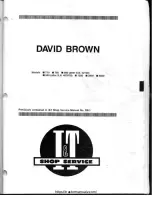
Maintenance, Service, and Repair
Batteries
Page 6
A battery is a live electrical source. It
cannot be disconnected or neutralized. Do
not drop any tool or conductive object onto
the battery. A conductive object that comes
in contact with the battery terminals will
initiate a short circuit of the battery. This
could cause the battery to explode
resulting in severe bodily injury and/or
property damage.
Battery electrolyte is poisonous and
dangerous. It contains sulfuric acid. Avoid
contact with skin eyes or clothing. Wear
rubber gloves and safety glasses while
servicing batteries. DO NOT INGEST! This
may result in severe bodily injury.
15. Install the batteries in reverse order. Refer to the
Illustrated Parts List
for battery cable routing.
16. It is recommended to replace the battery terminal
hardware when replacing the batteries.
17. Torque the terminal hardware to 7-8 ft.-lbs.
18. Tighten the hold downs so that the batteries are
secure but not so tight as to deform the batteries.
19. Remove the blocks from the wheels and test drive.
Moist Charge Batteries
Moist charged batteries are shipped without battery
electrolyte. This allows for a much greater shelf life of
the battery. Moist charged batteries must be filled with
electrolyte and charged before putting into service.
Battery electrolyte is a solution of acid and water that is
formulated to be used in wet lead acid batteries and is
available at most automotive parts distributors that carry
batteries.
When torquing battery hardware, use a
backup wrench on the battery bolt and
tighten the nut. Failure to use a backup
wrench may damage the battery post.
Do not operate or charge a vehicle
equipped with moist charged batteries until
the batteries have been filled with
electrolyte and charged. Operating or
charging moist charged batteries before
filling and charging will damage the
batteries resulting in premature failure of
the batteries.
Battery electrolyte will stain and corrode
most surfaces. Immediately and
thoroughly clean any surface outside of the
battery that the battery electrolyte comes
in contact with. Failure to clean may result
in property damage.
6. Fill all battery cells with electrolyte to the proper
level.
7. Thoroughly clean any spilled electrolyte from the
batteries or the ground. Refer to
Cleaning the
Batteries
for information on cleaning the
batteries.
8. Reconnect the battery cables, connect the
batteries to the charger and allow the charger to
complete one charging cycle.
9. Remove the blocks from the wheels and test drive.
The batteries are now ready to be put into service.
1. Make sure the key-switch is in the “OFF”
position, then remove the key.
2. Place the forward-reverse switch in the
center “OFF” position.
3. Confirm the electric park brake is applied.
4. Place blocks under the front wheels to
prevent vehicle movement.
5. Disconnect the main positive and negative
cables at the batteries.
Summary of Contents for TT-316-36
Page 2: ......
Page 6: ...TAYLOR DUNN...
Page 12: ...TAYLOR DUNN...
Page 28: ...TAYLOR DUNN...
Page 76: ...TAYLOR DUNN...
Page 82: ...TAYLOR DUNN...
Page 96: ...TAYLOR DUNN...
Page 99: ...Sevcon Troubleshooting Page 3 Electrical Troubleshooting Identifying Your Controller...
Page 120: ...TAYLOR DUNN...
Page 134: ...TAYLOR DUNN...
Page 138: ...Illustrated Parts Page 2 Front Fork...
Page 140: ...Illustrated Parts Page 4 Front Brakes...
Page 142: ...Illustrated Parts Page 6 Tilt Steering Column and Gear...
Page 146: ...Illustrated Parts Page 10 Transmission Differential Case Rear Axle...
Page 148: ...Illustrated Parts Page 12 Rear Brakes Master Cylinder 8 Brake Body...
Page 150: ...Illustrated Parts Page 14 Rear Suspension...
Page 152: ...Illustrated Parts Page 16 Motor...
Page 156: ...Illustrated Parts Page 20 Brake Lines...
Page 158: ...Illustrated Parts Page 22 Wheels and Tires Ref wheel hub 1 2 5 assembly 4 3 6 7 8 9 10...
Page 164: ...Illustrated Parts Page 28 Miscellaneous Frame and Body...
Page 168: ...Illustrated Parts Page 32 Decals...
Page 172: ...TAYLOR DUNN...
















































